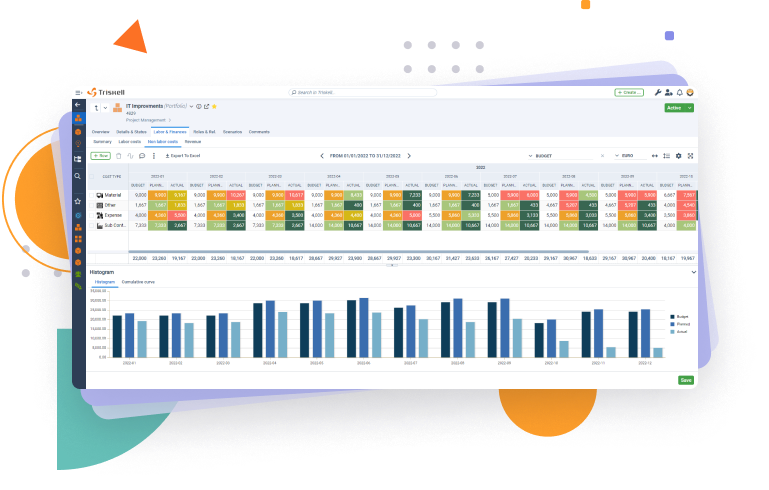10 types of Project Management Offices (PMO): structure, purpose and how to choose the right one

Does your organization need a PMO? And, if so, what would be the most appropriate model? Project Management Offices are no longer a single concept. Depending on the level of governance, control and strategic alignment a company requires, there are different types of PMOs with very different functions and approaches.
In this article, we will explore the top 10 types of PMOs, their key differences and where to implement them. From more flexible models, such as the Supportive PMO, to highly strategic structures, such as the EPMO or VMO, we will see how each PMO type responds to specific management needs.
PMO type #1: Supportive PMO
Let’s start with what is probably the most common type of PMO. A Supportive PMO functions as an advisory entity, meaning it provides guidance, templates, training, and tools to project teams without enforcing strict governance.
Structure and role
- Acts as a knowledge repository, offering tools, resources, and best practices related to project management methodologies and frameworks.
- Provides assistance to project teams and project managers but does not directly interfere with project execution.
- Encourages collaboration and knowledge-sharing across departments.
Purpose
- Improve project success rates by equipping teams with the necessary tools and resources for efficient performance.
- Promote continuous learning and process improvement within the organization.
- Serve as a center of excellence in project management.
Best fit for organizations that:
- Operate in agile and dynamic industries, such as tech companies or R&D departments.
- Have experienced and self-sufficient project managers who require only minimal guidance.
- Foster innovation and autonomy within project teams.

PMO MANAGEMENT
The smartest way to manage your projects and portfolios
Discover how Triskell Software enables PMO leaders to drive efficiency, governance, and strategic alignment.
PMO type #2: Controlling PMO
Unlike a Supportive PMO, a Controlling PMO ensures that all teams follow defined procedures by enforcing standardized processes, regulatory compliance, and governance frameworks across all projects.
Structure and role
- Defines project governance policies and oversees their enforcement.
- Implements mechanisms to track project performance and ensure alignment with established standards.
- Allows some flexibility for project teams in areas like risk management but enforces a structured decision-making process.
Purpose
- Ensure consistent project execution across the organization.
- Improve visibility into project performance and adherence to established procedures.
- Focus on risk management and regulatory compliance.
Best fit for organizations that:
- Operate in highly regulated industries such as healthcare, finance, or government.
- Need to enforce standardized project management frameworks across the entire corporation.
- Require greater accountability and structured reporting in their projects.
Supportive PMO vs controlling PMO
Feature |
Supportive PMO |
Controlling PMO |
|---|---|---|
|
Governance |
Low – provides guidance but no enforcement. |
High – enforces compliance and processes. |
|
Flexibility |
High – project teams have autonomy. |
Moderate – teams must follow defined frameworks. |
|
Role in project execution |
Advisory – offers templates, tools, and best practices. |
Regulatory – ensures compliance and process adherence. |
|
Best for |
Agile and innovative environments. |
Regulated industries and structured organizations. |
PMO type #3: Directive PMO
A Directive PMO takes full control over projects. It directly manages project execution, resource allocation, and decision-making. This type of PMO is commonly found in organizations that require a high level of governance and rigorous control over their project portfolios.
Structure and role
- Manages projects directly, with project managers reporting directly to the PMO leader.
- Defines all aspects of project planning and management, including project roadmaps, task prioritization, and the project management methodologies to be used.
- Ensures that all decisions align with corporate strategy and financial objectives.
Purpose
- Provide a single point of control over all project activities.
- Maximize the efficient use of resources.
- Strengthen strategic alignment between corporate goals and project execution.
Best fit for organizations that:
- Require strict governance over project execution.
- Manage large and complex project portfolios where strategic alignment is critical.
- Operate in highly structured industries, such as Aerospace or Defense.
SUBSCRIBE TO OUR NEWSLETTER
Get stories like this in your inbox
PMO type #4: Enterprise PMO
Now, let’s move on to the Enterprise PMO (also known as EPMO). EPMOs operate at the highest strategic level, ensuring that all projects align with corporate objectives. Unlike other types of PMOs that focus more on operational execution, the EPMO oversees all project portfolios, driving business transformation and long-term success.
Structure and role
- Reports directly to executive leadership (CIO, CFO, CTO, etc.)
- Aligns project prioritization and execution with business objectives.
- Implements enterprise-wide frameworks, KPIs, and project performance metrics.
Purpose
- Ensure strategic alignment between projects and business goals.
- Optimize resource allocation across all project portfolios.
- Strengthen collaboration and synergies across different areas and departments within the organization.
Best fit for organizations that:
- Manage large and complex project portfolios with a strong strategic focus.
- Need to ensure that projects contribute to long-term business growth.
- Operate in industries such as Banking, Insurance, or Telecommunications.

PROJECT PORTFOLIO MANAGEMENT
Bridge the gap between strategy and execution with Triskell
Align your portfolio with business objectives and maximize value with Triskell Software.
PMO type #5: Strategic PMO
Just like an Enterprise PMO, a Strategic PMO also ensures that projects contribute to long-term business objectives. However, there are key differences between the two.
We already mentioned that the EPMO oversees and governs all project management activities across the organization. The primary role of the Strategic PMO, however, is to select and prioritize projects based on their strategic impact on the business, ensuring they receive the appropriate resources and funding.
Structure and role
- Works closely with executive leadership to prioritize projects based on their business impact.
- Leverages data analytics, Artificial Intelligence, and KPI tracking to measure project success.
Purpose
- Maximize business value from project investments.
- Optimize resource allocation for high-priority initiatives.
- Ensure projects are closely aligned with corporate objectives.
Best fit for organizations that:
- Operate in fast-evolving industries such as technology or financial services.
- Require seamless portfolio management to balance innovation and risk.
ON-DEMAND WEBINAR
How to transform your PMO into a strategic PMO
PMO type #6: Departmental PMO
Unlike other enterprise-wide PMOs, Departmental PMOs focus on supporting projects within specific business units, with the most common being IT and R&D departments.
Structure and role
- Reports to the head of the department in which it operates, with its primary responsibility being to ensure project alignment with the unit’s business objectives.
- Implements standardized project management methodologies within the department.
- Coordinates with the EPMO or executive leadership to ensure broader alignment with corporate strategy.
Purpose
- Improve efficiency in project management within the department.
- Strengthen collaboration between different teams within the business unit.
- Align projects with department-specific KPIs and organizational needs.
Best fit for organizations that:
- Have business units with unique project management requirements.
- Require a tailored PMO model for highly specialized technical areas.
EPMO vs Departmental PMO: key differences
Feature |
EPMO |
Departmental PMO |
|---|---|---|
|
Scope |
Corporate-wide oversight. |
Focused on a single department. |
|
Governance level |
High. |
Moderate. |
|
Focus |
Aligns projects with corporate objectives. |
Aligns projects with department objectives. |
|
Best for |
Large companies with complex project portfolios. |
Companies with strong departmental autonomy. |
PMO type #7: Dedicated PMO
Now, let’s move on to the Dedicated PMO. Unlike all previous PMO models, which have either a departmental or enterprise-wide scope, a Dedicated PMO is temporary and created to oversee a single, highly relevant and complex project for an organization. This PMO operates independently for the duration of the project and is dissolved once it is successfully completed.
Structure and role
- Assembles a multidisciplinary team to manage a high-impact project.
- Oversees budgeting, resource management, governance, and risk management for that specific initiative.
- It is terminated upon successful completion of the project.
Purpose
- Provide dedicated oversight for the most critical business projects.
- Improve efficiency in large-scale or high-risk initiatives.
- Centralize the management of key projects within the organization.
Best fit for organizations that:
- Plan to execute large-scale transformation programs.
- Require a temporary governance structure for certain projects to ensure regulatory compliance and effective risk management.
The right PMO needs the right PMO tools.
From Agile to Strategic PMOs, Triskell Software helps you streamline project governance and execution. Request your demo today!
PMO type #8: Agile PMO
The next type of PMO we will analyze is the Agile PMO. This model is designed for organizations that follow Agile frameworks, such as Scrum, Kanban, or SAFe. Unlike traditional PMOs, Agile PMOs prioritize flexibility, continuous iteration, and adaptive governance.
Structure and role
- Promotes the adoption and optimization of Agile methodologies by providing resources and best practices.
- Supports Scrum teams and Agile coaches to ensure project alignment with business strategy.
- Leverages real-time data analytics and task automation to monitor project velocity and measure success.
Purpose
- Enhance an organization’s agility and adaptability in project execution.
- Eliminate bureaucratic barriers to facilitate team collaboration.
- Ensure projects remain aligned with business objectives at all times.
Best fit for organizations that:
- Operate in fast-paced, ever-changing environments, such as software development or digital transformation.
- Prioritize speed, innovation, and iterative development.
- Seek to scale Agile practices beyond IT and Development teams.
Agile PMO vs Strategic PMO: key differences
Feature |
Agile PMO |
Strategic PMO |
|---|---|---|
|
Methodology |
Agile frameworks - Kanban, Scrum, SAFe. |
Hybrid project management. |
|
Governance level |
Low – emphasizes flexibility. |
High – enforces alignment with corporate goals. |
|
Focus |
Speed and adaptability. |
Long-term strategic alignment. |
|
Best for |
Startups, tech firms, and digital-first companies. |
Enterprises with strong corporate planning. |
PMO type #9: Center of Excellence (CoE) PMO
A Center of Excellence (CoE) PMO is primarily focused on developing best practices, training, and innovation within project management. It does not directly manage projects but helps enhance the maturity of project management processes across the organization.
Structure and role
- Designs and implements training, certification, and mentorship programs in project management.
- Establishes best practices and process improvements.
Purpose
- Improve competency and consistency in project management.
- Foster innovation and process optimization.
- Serve as a repository of knowledge and expertise in project management.
Best fit for organizations that:
- Aim to enhance project management maturity across all teams.
- Want to invest in long-term capability development.
- Require a standardized knowledge-sharing and best practices model across business units.

STRATEGIC PORTFOLIO MANAGEMENT
Drive business value with Triskell
Gain full control over strategic portfolios and ensure business goals are met efficiently.
PMO type #10: Value Management Office (VMO)
The last type of PMO we are covering in this post is the Value Management Office (VMO). This entity focuses on maximizing business value from project investments. Unlike a traditional PMO, which generally measures success based on the percentage of projects completed within defined timelines and budgets, a VMO evaluates impact in terms of strategic benefits and ROI.
Structure and role
- Aligns project portfolios with business value and customer impact.
- Works closely with financial controllers and executive leadership to optimize investments.
Purpose
- Shift project management to a value-driven approach, using performance metrics specifically designed for this purpose.
- Ensure that projects generate tangible and measurable business benefits.
- Improve investment decision-making through strategic portfolio management.
Best fit for organizations that:
- Prioritize decision-making based on business value.
- Operate in highly competitive industries, where ROI is a critical success factor for projects.
- Seek to align project management with financial outcomes and customer satisfaction.
PMO vs VMO: key differences explained
Feature |
VMO |
PMO |
|---|---|---|
|
Focus |
Business impact and value creation. |
Governance and execution. |
|
Governance level |
High - ensures that projects maximize strategic value. |
High - focus on standardization and compliance of processes. |
|
Metrics used |
ROI, strategic benefits, customer impact. |
Budget, schedule, scope . |
|
Best for |
Value-driven enterprises. |
Process-driven organizations. |
Choosing the right PMO Type for your organization: key takeaways
Selecting the right PMO model for your organization largely depends on factors such as project management maturity, the presence of Agile teams, and the required level of governance and flexibility. Here are some key considerations to help you determine the most suitable PMO type:
Priority |
PMO type |
|---|---|
|
Agility and Innovation |
|
|
Process standardization and regulatory compliance |
|
|
Alignment with corporate objectives |
|
|
Strategic impact and higher ROI |
|
|
Department-Specific Project Management |
|
However, choosing the right model is not the only key to a PMO’s success. Today’s Project Management Offices must leverage PPM tools like Triskell Software to improve decision-making and optimize portfolio management.
So, what are you waiting for? Request a demo of Triskell today and see its benefits for yourself!
The right PMO needs the right PMO tools
From Agile to Strategic PMOs, Triskell Software helps you streamline project governance and execution. Request your demo today!

Related Content

How to create a project budget: methods and techniques for effective project budgeting
Learn how to create a project budget with this detailed guide. Discover essential methods and techniques for effective project budgeting in PPM.

20 strategic planning models and tools for medium and large companies
Looking for the best strategic planning frameworks? This guide covers 20 proven models to enhance decision-making and business growth.

The ultimate guide to Scenario Analysis for PPM: how it works, examples, techniques and tools
Master scenario analysis for PPM. Discover how to apply scenario planning for resource management, budgeting, and strategic decision-making.
FAQ Types of PMO
How do PMOs integrate with PPM software like Triskell?
PPM software like Triskell helps PMOs streamline portfolio management, automate reporting, optimize resource allocation, and enhance decision-making with real-time data and AI-driven insights.
How can an organization decide which PMO type is best for its needs?
Organizations should assess their strategic goals, governance requirements, and project complexity. Agile environments benefit from Supportive or Agile PMOs, while regulated industries need Controlling or EPMOs.
Are there industry-specific best practices for selecting a type of PMO?
Yes. Tech and startups favor Agile PMOs, financial and healthcare sectors require Controlling or Strategic PMOs, while large enterprises benefit from EPMOs for strategic alignment.
Can a company have more than one type of PMO?<
Absolutely. Many organizations combine multiple PMO types, such as having an EPMO for governance and Departmental PMOs for execution.

